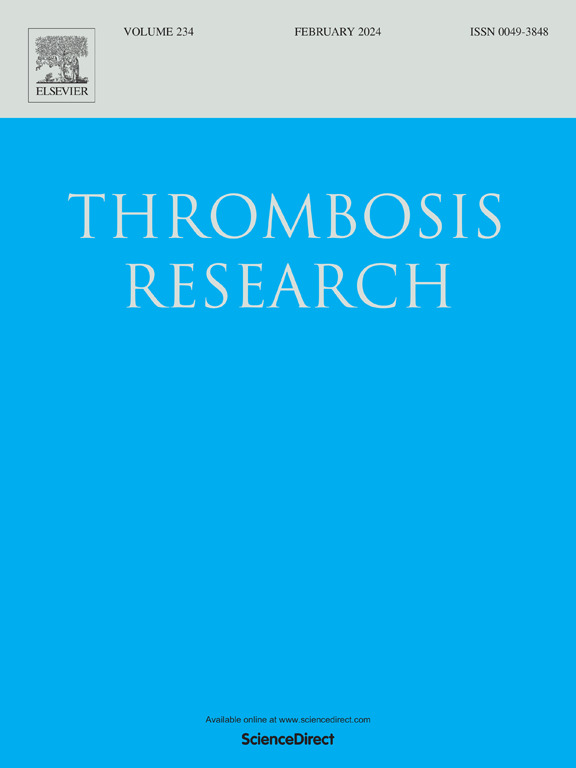Sepsis-related coagulation-inflammation score: Development and validation for predicting 28-day mortality in patients with sepsis
IF 3.4
3区 医学
Q1 HEMATOLOGY
引用次数: 0
Abstract
Background
Sepsis remains a leading cause of mortality in intensive care units worldwide, characterized by dysregulated host response to infection involving complex interactions between coagulation and inflammatory pathways. Current prognostic tools have limitations in capturing this pathophysiological interplay. This study aimed to develop and validate a novel Sepsis-related Coagulation-Inflammation Score (SCIS) to predict 28-day mortality in sepsis patients.
Methods
We conducted a retrospective observational study of adult patients diagnosed with sepsis according to Sepsis-3 criteria at a tertiary medical center between January 2017 and December 2022. Demographic data, clinical characteristics, coagulation parameters (platelet count, prothrombin time, activated partial thromboplastin time, D-dimer, fibrinogen), and inflammatory markers (C-reactive protein, procalcitonin, interleukin-6, white blood cell count, neutrophil-to-lymphocyte ratio) were collected. Univariate and multivariate logistic regression analyses identified significant predictors of 28-day mortality. The SCIS was developed by assigning weighted points to independent predictors. Receiver operating characteristic (ROC) curve analysis, calibration plots, and decision curve analysis evaluated the score's predictive performance and clinical utility. The score was compared with established sepsis severity scores including SOFA, APACHE II, and DIC scores.
Results
Among 578 sepsis patients, 28-day mortality was 32.7 %. The final SCIS incorporated five parameters: platelet count, D-dimer, prothrombin time, procalcitonin, and interleukin-6. The SCIS demonstrated excellent discriminative ability for predicting 28-day mortality (AUC 0.86, 95 % CI 0.83–0.89), superior to SOFA (AUC 0.79), APACHE II (AUC 0.77), and DIC score (AUC 0.74). The score maintained robust performance across subgroups stratified by infection site, comorbidities, and organ dysfunction. A SCIS ≥10 was associated with a 5.8-fold increased risk of 28-day mortality (95 % CI 4.2–7.9, p < 0.001).
Conclusion
The Sepsis-related Coagulation-Inflammation Score effectively integrates coagulation and inflammatory parameters to predict 28-day mortality in sepsis patients. This novel scoring system provides enhanced prognostic accuracy compared to established scores and may facilitate early risk stratification, therapeutic decision-making, and resource allocation in sepsis management.
脓毒症相关凝血炎症评分:预测脓毒症患者28天死亡率的发展和验证
脓毒症仍然是全世界重症监护病房死亡的主要原因,其特点是宿主对感染的反应失调,涉及凝血和炎症途径之间的复杂相互作用。目前的预后工具在捕捉这种病理生理相互作用方面存在局限性。本研究旨在开发和验证一种新的脓毒症相关凝血炎症评分(SCIS),以预测脓毒症患者的28天死亡率。方法对2017年1月至2022年12月在某三级医疗中心根据脓毒症-3标准诊断为脓毒症的成年患者进行回顾性观察研究。收集人口统计学资料、临床特征、凝血参数(血小板计数、凝血酶原时间、活化部分凝血活酶时间、d -二聚体、纤维蛋白原)和炎症标志物(c反应蛋白、降钙素原、白细胞介素-6、白细胞计数、中性粒细胞与淋巴细胞比值)。单变量和多变量逻辑回归分析确定了28天死亡率的显著预测因素。SCIS是通过给独立的预测因子分配加权点来开发的。受试者工作特征(ROC)曲线分析、校准图和决策曲线分析评估评分的预测性能和临床应用。将该评分与已建立的脓毒症严重程度评分进行比较,包括SOFA、APACHE II和DIC评分。结果578例败血症患者28天死亡率为32.7%。最终的SCIS包括5个参数:血小板计数、d -二聚体、凝血酶原时间、降钙素原和白细胞介素-6。SCIS在预测28天死亡率方面表现出出色的判别能力(AUC 0.86, 95% CI 0.83-0.89),优于SOFA (AUC 0.79)、APACHE II (AUC 0.77)和DIC评分(AUC 0.74)。该评分在按感染部位、合并症和器官功能障碍分层的亚组中保持了稳健的表现。SCIS≥10与28天死亡风险增加5.8倍相关(95% CI 4.2-7.9, p < 0.001)。结论脓毒症相关凝血-炎症评分可有效综合凝血和炎症参数预测脓毒症患者28天死亡率。与现有评分相比,这种新颖的评分系统可提高预后准确性,并可促进败血症管理中的早期风险分层、治疗决策和资源分配。
本文章由计算机程序翻译,如有差异,请以英文原文为准。
求助全文
约1分钟内获得全文
求助全文
来源期刊

Thrombosis research
医学-外周血管病
CiteScore
14.60
自引率
4.00%
发文量
364
审稿时长
31 days
期刊介绍:
Thrombosis Research is an international journal dedicated to the swift dissemination of new information on thrombosis, hemostasis, and vascular biology, aimed at advancing both science and clinical care. The journal publishes peer-reviewed original research, reviews, editorials, opinions, and critiques, covering both basic and clinical studies. Priority is given to research that promises novel approaches in the diagnosis, therapy, prognosis, and prevention of thrombotic and hemorrhagic diseases.
 求助内容:
求助内容: 应助结果提醒方式:
应助结果提醒方式:


